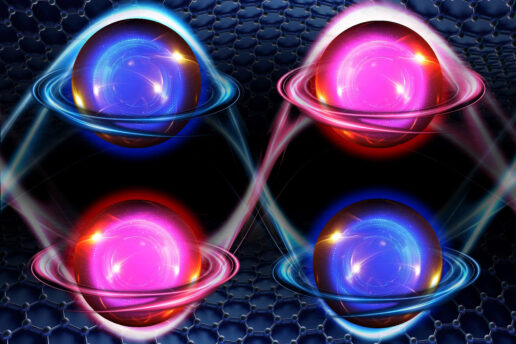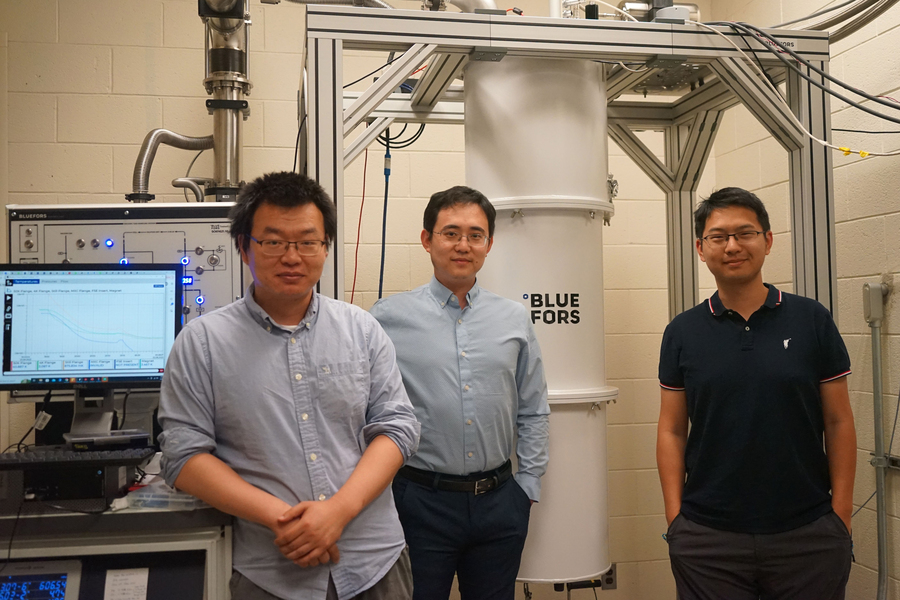
From a five-layer graphene sandwich, a rare electronic state emerges
A newly discovered type of electronic behavior could help with packing more data into magnetic memory devices.
Ordinary pencil lead holds extraordinary properties when shaved down to layers as thin as an atom. A single, atom-thin sheet of graphite, known as graphene, is just a tiny fraction of the width of a human hair. Under a microscope, the material resembles a chicken-wire of carbon atoms linked in a hexagonal lattice.
Despite its waif-like proportions, scientists have found over the years that graphene is exceptionally strong. And when the material is stacked and twisted in specific contortions, it can take on surprising electronic behavior.
Now, MIT physicists have discovered another surprising property in graphene: When stacked in five layers, in a rhombohedral pattern, graphene takes on a very rare, “multiferroic” state, in which the material exhibits both unconventional magnetism and an exotic type of electronic behavior, which the team has coined ferro-valleytricity.
“Graphene is a fascinating material,” says team leader Long Ju, assistant professor of physics at MIT. “Every layer you add gives you essentially a new material. And now this is the first time we see ferro-valleytricity, and unconventional magnetism, in five layers of graphene. But we don’t see this property in one, two, three, or four layers.”
The discovery could help engineers design ultra-low-power, high-capacity data storage devices for classical and quantum computers.
“Having multiferroic properties in one material means that, if it could save energy and time to write a magnetic hard drive, you could also store double the amount of information compared to conventional devices,” Ju says.
His team reports their discovery today in Nature. MIT co-authors include lead author physics graduate student Tonghang Han, plus Zhengguang Lu, Tianyi Han, and Liang Fu; along with Harvard University collaborators Giovanni Scuri, Jiho Sung, Jue Wang, and Hongkun Park; and Kenji Watanabe and Takashi Taniguchi of the National Institute for Materials Science in Japan.
A preference for order
A ferroic material is one that displays some coordinated behavior in its electric, magnetic, or structural properties. A magnet is a common example of a ferroic material: Its electrons can coordinate to spin in the same direction without an external magnetic field. As a result, the magnet points to a preferred direction in space, spontaneously.
Other materials can be ferroic through different means. But only a handful have been found to be multiferroic — a rare state in which multiple properties can coordinate to exhibit multiple preferred states. In conventional multiferroics, it would be as if, in addition to the magnet pointing toward one direction, the electric charge also shifts in a direction that is independent from the magnetic direction.
Multiferroic materials are of interest for electronics because they could potentially increase the speed and lower the energy cost of hard drives. Magnetic hard drives store data in the form of magnetic domains — essentially, microscopic magnets that are read as either a 1 or a 0, depending on their magnetic orientation. The magnets are switched by an electric current, which consumes a lot of energy and cannot operate quickly. If a storage device could be made with multiferroic materials, the domains could be switched by a faster, much lower-power electric field. Ju and his colleagues were curious about whether multiferroic behavior would emerge in graphene. The material’s extremely thin structure is a unique environment in which researchers have discovered otherwise hidden, quantum interactions. In particular, Ju wondered whether graphene would display multiferroic, coordinated behavior among its electrons when arranged under certain conditions and configurations.
“We are looking for environments where electrons are slowed down — where their interactions with the surrounding lattice of atoms is small, so that their interactions with other electrons can come through,” Ju explains. “That’s when we have some chance of seeing interesting collective behaviors of electrons.”
The team carried out some simple calculations and found that some coordinated behavior among electrons should emerge in a structure of five graphene layers stacked together in a rhombohedral pattern. (Think of five chicken-wire fences, stacked and slightly shifted such that, viewed from the top, the structure would resemble a pattern of diamonds.)
“In five layers, electrons happen to be in a lattice environment where they move very slowly, so they can interact with other electrons effectively,” Ju says. “That’s when electron correlation effects start to dominate, and they can start to coordinate into certain preferred, ferroic orders.”
Magic flakes
The researchers then went into the lab to see whether they could actually observe multiferroic behavior in five-layer graphene. In their experiments, they started with a small block of graphite, from which they carefully exfoliated individual flakes. They used optical techniques to examine each flake, looking specifically for five-layer flakes, arranged naturally in a rhombohedral pattern.
“To some extent, nature does the magic,” said lead author and graduate student Han. “And we can look at all these flakes and tell which has five layers, in this rhombohedral stacking, which is what should give you this slowing-down effect in electrons.”
The team isolated several five-layer flakes and studied them at temperatures just above absolute zero. In such ultracold conditions, all other effects, such as thermally induced disorders within graphene, should be dampened, allowing interactions between electrons, to emerge. The researchers measured electrons’ response to an electric field and a magnetic field, and found that indeed, two ferroic orders, or sets of coordinated behaviors, emerged.
The first ferroic property was an unconventional magnetism: The electrons coordinated their orbital motion, like planets circling in the same direction. (In conventional magnets, electrons coordinate their “spin” — rotating in the same direction, while staying relatively fixed in space.)
The second ferroic property had to do with graphene’s electronic “valley.” In every conductive material, there are certain energy levels that electrons can occupy. A valley represents the lowest energy state that an electron can naturally settle. As it turns out, there are two possible valleys in graphene. Normally, electrons have no preference for either valley and settle equally into both.
But in five-layer graphene, the team found that the electrons began to coordinate, and preferred to settle in one valley over the other. This second coordinated behavior indicated a ferroic property that, combined with the electrons’ unconventional magnetism, gave the structure a rare, multiferroic state.

“We knew something interesting would happen in this structure, but we didn’t know exactly what, until we tested it,” says co-first author Lu, a postdoc in Ju’s group. “It’s the first time we’ve seen a ferro-valleytronics, and also the first time we’ve seen a coexistence of ferro-valleytronics with unconventional ferro-magnet.”
The team showed they could control both ferroic properties using an electric field. They envision that, if engineers can incorporate five-layer graphene or similar multiferroic materials into a memory chip, they could, in principle, use the same, low-power electric field to manipulate the material’s electrons in two ways rather than one, and effectively double the data that could be stored on a chip compared to conventional multiferroics. While that vision is far from practical realization, the team’s results break new ground in the search for better, more efficient electronic, magnetic and valleytronic devices.
This research is funded, in part, by the National Science Foundation and the Sloan Foundation.
- Paper: “Orbital Multiferroicity in Pentalayer Rhombohedral Graphene”
- Open-access Paper: “Orbital Multiferroicity in Pentalayer Rhombohedral Graphene”